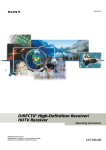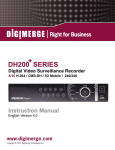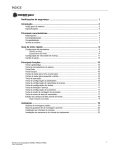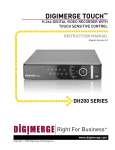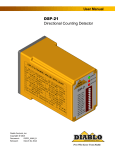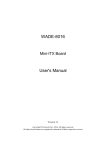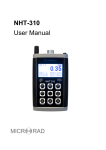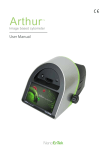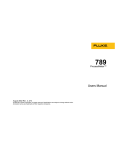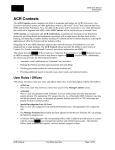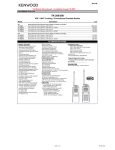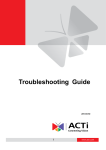Download SeedManager
Transcript
CONTENTS INTRODUCTION ................................................................................................................. 1 A . SYSTEM OVERVIEW ............................................................................................................ 1 B. SWITCH OVERVIEW ............................................................................................................ 2 1. 2. 3. 4. 5. 6. 7. ON•OFF .................................................................................................................................................. 2 ALARM .................................................................................................................................................... 2 SETUP ..................................................................................................................................................... 2 MIN-AVG-MAX•SCAN ...................................................................................................................... 2 SELECT ROW ....................................................................................................................................... 2 SELECT, SET, and CLEAR ................................................................................................................. 2 START•STOP ....................................................................................................................................... 2 SETUP MODE ........................................................................................................................ 3 A . CUSTOMER SETUP CONFIGURATION ........................................................................ 3 1. 2. 3. 4. 5. 6. 7. 8. 9. 10. Ground Speed Sensor Type ............................................................................................................... 4 Shaft Speed Sensor Type .................................................................................................................... 4 Hopper Level 1 Sensor Enable ......................................................................................................... 4 Hopper Level 2 Sensor Enable ......................................................................................................... 5 Pressure 1 Sensor Enable .................................................................................................................... 5 Pressure 2 Sensor Enable .................................................................................................................... 6 Population Filter Value ....................................................................................................................... 6 Population Scaling Factor .................................................................................................................. 6 Boot Version Numbers ......................................................................................................................... 7 Flash Version Numbers ........................................................................................................................ 8 B. SETUP CONSTANTS ............................................................................................................. 9 1. 2. 3. 4. 5. 6. 7. 8. 9. 10. 11. 12. 13. 14. 15. IMPlement Type Configuration ......................................................................................................... 10 ROW Status ............................................................................................................................................ 11 POPULATION HI LIMIT .................................................................................................................... 12 POPULATION LO LIMIT ................................................................................................................... 12 NUMber of ROWS ................................................................................................................................ 13 ROW WIDTH ........................................................................................................................................ 13 IMPlement WIDTH ............................................................................................................................... 14 Shaft Speed Constant ........................................................................................................................... 14 RPM HI LIMIT (Shaft Speed) ........................................................................................................... 15 RPM LO LIMIT (Shaft Speed) ........................................................................................................... 15 Hi Pressure Warning Limit .................................................................................................................. 16 Lo Pressure Warning Limit ................................................................................................................. 16 Distance Calibration ............................................................................................................................. 17 Sensor Self-Test ..................................................................................................................................... 18 English/METRIC Units Selection ...................................................................................................... 19 OPERATE MODE ................................................................................................................. 21 A . OPERATE MODE .................................................................................................................... 21 1. Run Hours .............................................................................................................................................. 21 2. Population ............................................................................................................................................... 22 a. Population SCAN ................................................................................................................................ 22 b. Population MIN-AVG-MAX .............................................................................................................. 23 c. Population SELECT ROW ................................................................................................................ 23 3. Seed Spacing ......................................................................................................................................... 24 4. Singulation .............................................................................................................................................. 24 5. Speed ....................................................................................................................................................... 25 6. Shaft Speed ............................................................................................................................................ 25 7. Distance Accumulator .......................................................................................................................... 26 8. Area Accumulator 1 ............................................................................................................................ 26 9. Area Accumulator 2 ............................................................................................................................ 27 10. Area Accumulator 3 ............................................................................................................................. 27 11. Seed Count ............................................................................................................................................. 28 B. SPEED-AREA MODE .............................................................................................................. 28 C . POPULATION BARGRAPH ................................................................................................. 29 D . BARGRAPH LOCK & HOLD ............................................................................................... 31 ALARMS & ERROR CODES ............................................................................................. 33 A . ALARMS ..................................................................................................................................... 33 1. 2. 3. 4. 5. 6. 7. 8. 9. 10. 11. 12. Distance Sensor FAILED .................................................................................................................... 33 ROW FAILED ........................................................................................................................................ 34 All ROWS FAILED .............................................................................................................................. 34 Lock-On ROW FAILED ...................................................................................................................... 35 POPULATION HI LIMIT Warning ................................................................................................... 35 POPULATION LO LIMIT Warning .................................................................................................. 36 RPM HI LIMIT (Shaft Speed) Warning .......................................................................................... 36 RPM LO LIMIT (Shaft Speed) Warning ......................................................................................... 36 HI PRESSURE Limit Warning ......................................................................................................... 36 LO PRESSURE Limit Warning ........................................................................................................ 36 HOPPER LO Warning ......................................................................................................................... 38 Battery Voltage Warning ..................................................................................................................... 38 B. ERROR CODES ........................................................................................................................ 39 SYSTEM INSTALLATION ................................................................................................. 41 A. B. C. D. E. F. G. CONSOLE MOUNTING ........................................................................................................ 41 CONSOLE HARNESSES INSTALLATION .................................................................... 42 GROUND SPEED SENSOR INSTALLATION ............................................................... 44 OTHER SENSORS .................................................................................................................. 45 POWER CONNECTION ........................................................................................................ 46 SEED SENSORS ....................................................................................................................... 47 PLANTER HARNESS ............................................................................................................. 48 1. STANDARD and HI-RATE HARNESSES INSTALLATION ..................................................... 48 2. SQUADRON HARNESS INSTALLATION ..................................................................................... 49 3. SEED SMART® HARNESS INSTALLATION .............................................................................. 50 TROUBLESHOOTING ........................................................................................................ 51 A. B. C. D. E. F. G. H. I. J. K. L. M. N. O. P. MONITOR DEAD .................................................................................................................................... 51 BATTERY SYMBOL APPEARS ON DISPLAY .............................................................................. 51 ERROR CODE E 020 ............................................................................................................................. 51 ERROR CODE E 021 ............................................................................................................................. 51 ERROR CODE E 060 ............................................................................................................................. 52 ERROR CODE E 062 ............................................................................................................................. 52 ERROR CODE E 063 ............................................................................................................................. 52 ERROR CODE E 064 ............................................................................................................................. 52 ERROR CODE E 065 ............................................................................................................................. 53 ERROR CODE E 066 ............................................................................................................................. 53 ERROR CODE E 067 ............................................................................................................................. 53 ERROR CODE E 080 ............................................................................................................................. 53 ERROR CODE E 081 ............................................................................................................................. 54 ERROR CODE E 082 ............................................................................................................................. 54 ERROR CODE HOPPER FAILURE ................................................................................................... 54 ERROR CODE PRESSURE FAILURE ............................................................................................... 54 SETUP RECORD SHEET .................................................................................................... 55 OPERATOR'S MANUAL ® INTRODUCTION A. SYSTEM OVERVIEW The DICKEY-john Seed Manager® Population Monitor uses the latest microprocessor-based technology to take the guesswork out of the planting operation. Any time seeds are not going to the ground at the correct rate or another error condition occurs, an alarm is sounded and a message and row number, if appropriate, are displayed. Seed Manager® offers features such as improved seed counting accuracy, simplified harnessing, advanced error diagnostics, and seed singulation when used with the new Seed Smart® sensors. It is also compatible with the DICKEY-john Standard and Hi-Rate seed sensors. Additional features include a bargraph presentation of row-to-row planter performance, high and low population warnings, faster population updates, and the ability to disable individual row sensors from the monitor. An RS-232 interface is available for precision farming applications. The Seed Manager® Population Monitor can monitor up to 36 rows. It stores planter configuration data and accumulated operational data in nonvolatile memory, retaining information even when disconnected from the tractor battery. Figure 1 shows the Seed Manager® Population Monitor console. It consists of two custom Liquid Crystal Displays (LCDs) and twelve membrane switches. The top LCD display shows messages for the selected Figure 1 Seed Manager® Console Dj SEED MANAGER ® PLANTER MONITOR BENCHMARK Series® 11001-1103A-200111 INTRODUCTION/ 1 OPERATOR'S MANUAL Operate Mode function, Setup Mode constant, or Alarm Mode identifier and the value on a 5-digit numeric display. A 2-Digit numeric display identifies the row. The bottom LCD displays graphically the relative populations of 12 rows simultaneously. Larger planters have row groups displayed on a time-shared basis. B. SWITCH OVERVIEW The switches are used to control system power, select the mode of operation, and enter planter configuration constants. To help distinguish between switch names and display messages in the text of this manual, switch names are always shown in italicized print. An overview of the switches follows: 1. ON•OFF Pressing this switch applies power to the monitor. Upon power up, the monitor performs internal diagnostic checks, illuminates all segments of the LCDs, sounds the alarm, and determines what type of seed sensor harness is connected. Depressing the ON•OFF switch for at least one second causes the monitor to power down. 2. ALARM Momentarily pressing this switch silences the alarm and acknowledges the alarm condition. Additionally, holding the switch pressed for more than one second allows the volume level of the alarm to be adjusted. As the switch is held pressed, the alarm sounds continuously and the volume level slowly decreases to a minimum, 2/ INTRODUCTION then increases to a maximum. Releasing the switch establishes the desired volume level. 3. SETUP This switch is pressed for one (1) second to enter the Setup Mode and to step from one Setup constant to the next as detailed in the SETUP chapter. 4. MIN-AVG-MAX•SCAN This switch is pressed to toggle between the MIN-AVG-MAX and SCAN options for the function selected by the Population• Spacing•Singulation switch. 5. SELECT ROW Pressing this switch while in the Population, Spacing, or Singulation functions freezes the upper LCD display on the current row data. Successive depressions then cause stepping from one row to the next. In the Setup Mode, this switch allows stepping through the rows while entering Row Status. 6. SELECT, SET, and CLEAR These switches are used to change constants in the Setup Mode as explained in the SETUP chapter. The CLEAR switch is also used in the Operate Mode to reset the area and distance accumulators and the Run Hours function. The SELECT switch is used in the Operate Mode to select various Bargraph Display/Sections. 7. START•STOP This switch is used in the Operate Mode Seed Count, Distance Accumulator, and Bargraph Lock & Hold functions. In the Setup Mode, it is used for the Distance Calibration and the Sensor Self-Test. Dj SEED MANAGER ® PLANTER MONITOR BENCHMARK Series® 11001-1103A-200111 OPERATOR'S MANUAL SETUP MODE A. CUSTOMER SETUP CONFIGURATION Certain parameters must be entered in the Setup Configuration to the console. This mode is used to specify the types of ground speed and shaft speed sensors used, enable or disable hopper level sensors, to enable or disable pressure sensors, set population filter and scaling factor and identify the software version. The Setup Configuration is entered by holding the Setup switch depressed while powering on the console and continuing to hold it depressed until the Display Test begins. A flashing SETUP message indicates the console is in the Setup Configuration Mode. Additional messages uniquely identify the parameter displayed and available for editing. Use the SELECT, SET, and CLEAR switches as described previously to enter or change parameters. Also, press Setup, as before, to store the value and advance to the next parameter. To exit the Customer Setup Mode, power off the console. Figure 2 shows the Customer Setup parameters, in the order of their presentation. As before, record all parameter values on the SETUP RECORD sheet on the last page of this manual, immediately after console entry. Definitions and considerations when entering values for each parameter are as follows: Figure 2 Customer Setup Parameter Chart 1 2 3 4 5* 6* 7* 8* 9 10 Ground Speed Sensor Type Shaft Speed Sensor Type Hopper Level 1 Sensor Enable Hopper Level 2 Sensor Enable Hopper Pressure 1 Sensor Enable Hopper Pressure 2 Sensor Enable Population Filter Value Population Scaling Factor Boot Version Number Flash Version Number * New For Version 5.0 Software Dj SEED MANAGER® PLANTER MONITOR BENCHMARK Series® 11001-1103A-200111 SETUP MODE/ 3 OPERATOR'S MANUAL Figure 3 Ground Speed Sensor Type Display 1. Ground Speed Sensor Type This parameter allows choosing between a digital (radar or Hall Effect) type or reluctance type ground speed sensor. This parameter is identified by the message SPEED and a flashing SETUP message. Pressing the SET switch causes the lower, right display to toggle between a flashing "d1" or "r1". If a digital (radar or Hall Effect) type ground speed sensor is used, press the SET switch until "d1" appears. If a reluctance type ground speed sensor is used, press the SET switch until "r1" appears. Figure 3 shows a digital type ground speed sensor selected. 2. Shaft Speed Sensor Type This parameter allows choosing between a digital 1, digital 2, reluctance 1, or reluctance 2 type shaft speed sensor. This parameter is identified by the message RPM and a flashing SETUP message. Pressing the SET switch causes stepping between "d1, d2, r1, and r2" flashing on the lower, right display. The shaft speed sensor type used is clearly labeled on the sensor cable. Figure 4 shows a reluctance 2 type shaft speed sensor selected. 3. Hopper Level 1 Sensor Enable This parameter enables or disables the DICKEY-john Hopper Level 1 Sensor. It is identified by the message HOPPER, a "1" Figure 4 Shaft Speed Sensor Type Display 4/ SETUP MODE Dj SEED MANAGER® PLANTER MONITOR BENCHMARK Series® 11001-1103A-200111 OPERATOR'S MANUAL Figure 5 Hopper Level Sensor Display on the lower, right display, a flashing SETUP message, and either the ON or OFF message flashing. To enable or disable, press the SET switch to select ON or OFF respectively. Figure 5 shows the hopper level sensor is enabled. 4. Hopper Level 2 Sensor Enable This parameter enables or disables the DICKEY-john Hopper Level 2 Sensor. It is identified by the message HOPPER, a "2" on the lower, right display, a flashing SETUP message, and either the ON or OFF message flashing. To enable or disable, press the SET switch to select ON or OFF respectively. 5. Pressure 1 Sensor Enable This parameter enables or disables the hopper pressure sensor #1. This is identified on the display by the message “PRESS”, “1”, and the flashing SETUP icon. To enable disable, press the SET switch to select ON or OFF respectively. Figure 6 below shows PRESSURE 1 enabled. Figure 6 Pressure I Enable Dj SEED MANAGER® PLANTER MONITOR BENCHMARK Series® 11001-1103A-200111 SETUP MODE/ 5 OPERATOR'S MANUAL Figure 7 Pressure 2 Disable 6. Pressure 2 Sensor Enable This parameter enables or disables the hopper pressure sensor #2. This is identified on the display by the message “PRESS”, “2”, and the flashing SETUP icon. To enable/ disable, press the SET switch to select ON or OFF respectively. Figure 7 shows PRESSURE 2 disabled. singulation that are undesirable to the operator. The population filtering option applies an averaging filter to the population, and seed spacing calculations. The filter values range from 0 to 99, with 0 having no filtering effect and 99 being the maximum filtering value. Use the SET and SELECT switches to adjust the filtering value. Figure 8 shows a light filter value of 15. 7. Population Filter Value In certain applications the Seed Manager®, due to its rapid update rate, might exhibit fluctuations in population, spacing, and 8. Population Scaling Factor The population scaling factor allows the operator to make fine adjustments in the readout of population and spacing on a Figure 8 Filter Value 6/ SETUP MODE Dj SEED MANAGER® PLANTER MONITOR BENCHMARK Series® 11001-1103A-200111 OPERATOR'S MANUAL Figure 9 Population Scaling Factor percentage basis. This value is adjustable from 1% to 999% with the factory value being 100%. Use the SET and SELECT switches to adjust to the desired population scaling factor. Figure 9 shows a population scaling factor of 150%. Increasing this value results in an increase of population readout, while decreasing this value results in a decrease of the readout.. To decrease the population display 13%, enter 87%. 9. Boot Version Numbers DICKEY-john's Service department may request the customer to observe, record, and report back the four different 4-digit numbers (to identify the "boot memory" software version) in the unlikely event field problems occur. Examples: To increase the population display 15%, enter 115%. The first 4-digit number shows on the upper numeric display at the same time a "b1" identifier appears on the lower numeric Figure 10 Boot Number Dj SEED MANAGER® PLANTER MONITOR BENCHMARK Series® 11001-1103A-200111 SETUP MODE/ 7 OPERATOR'S MANUAL Figure 11 Flash Version Number display. Record this number, then press and release the SELECT switch to step to the "b2", "b3", and "bc" numbers, recording each 4-digit number along with its identifier. (To return to "b1", press SELECT again.) Press the SETUP switch to advance to the next constant. Figure 10 shows "0197" for "b1", the first Boot Version Number. identifier appears on the lower numeric display. Record this number, then press and release the SELECT switch to step to the "F2", "F3", and "Fc" numbers, recording each 4-digit number along with its identifier. (To return to "F1", press SELECT again.) Figure 11 shows "12bE" for "Fc", the last Flash Version Number. 10. Flash Version Numbers DICKEY-john's Service department may request the customer to observe, record, and report back the four different 4-digit numbers (to identify the "flash memory" software version) in the unlikely event field problems occur. Pressing the SETUP switch again causes a return to the first Customer Setup parameter, Ground Speed Sensor Type. To exit the Customer Setup Mode, power off the console. The first 4-digit number shows on the upper numeric display at the same time a "F1" 8/ SETUP MODE Dj SEED MANAGER® PLANTER MONITOR BENCHMARK Series® 11001-1103A-200111 OPERATOR'S MANUAL B. SETUP CONSTANTS The Setup Mode is used to enter the planter configuration constants which are listed in Figure 12, in the order of their presentation. Depressing the Setup switch for one (1) second places the console in the Setup Mode, which is identified by the SETUP message on the display. Additional messages uniquely identify the constant displayed and available for editing at any given time. Each constant has a fixed number of digits. Leading zeroes are displayed. When it is desired to change the value of a constant, use the SELECT, SET, and CLEAR switches as follows: Initially, the left most digit flashes on and off, indicating it is the “selected digit”. Each depression of the SET switch increases the selected digit by one count. After reaching the maximum value of nine (9), the digit rolls over to zero (0). Pressing CLEAR zeroes the digit. Each depression of the SELECT switch makes the next digit to the right the selected digit. When the desired value is entered (or there is no change from the original value), press the Setup switch to store the value and advance to the next constant on the list. If a value is entered which exceeds the minimum or maximum shown for that constant Figure 12 Setup Mode Parameters Order 1. 2. 3. 4. 5. 6. 7. 8. 9. 10. 11.* 12.* 13. 14. 15. SETUP Mode CONSTANT Name IMPlement Type Config. Row Status POPULATION HI LIMIT POPULATION LO LIMIT NUMber of ROWS ROW WIDTH IMPlement WIDTH Shaft Speed Constant RPM HI LIMIT RPM LO LIMIT Hi Pressure Lo Pressure Distance Calibration Sensor Self-Test English/METRIC Units Default Miniuum Maximum 01 ON 0034.0 0026.0 N/A 030.0 N/A 000.00 0065 0045 000.0 000.0 6096 N/A English 01 N/A 0000.0 0000.0 1 001.0 0001.0 000.00 0000 0000 000.0 000.0 250 N/A N/A N/A N/A 9999.9 9999.9 36 999.9 9999.9 999.99 9999 9999 999.9 999.9 9999 N/A N/A * IF PRESSURE SENSORS HAVE NOT BEEN ENABLED, THESE CONSTANTS ARE SKIPPED Dj SEED MANAGER® PLANTER MONITOR BENCHMARK Series® 11001-1103A-200111 SETUP MODE/ 9 OPERATOR'S MANUAL in Figure 12, the alarm sounds for one (1) second, the value of the exceeded limit appears on the screen, and the advance to the next constant is aborted. CAUTION: To allow rapid recovery from an entry error, it is important to record all values of constants on the SETUP RECORD sheet on the last page of this manual, immediately after console entry. To exit the Setup Mode, press any of the three Operate Mode switches (Population •Spacing•Singulation, Area• Seed Count, or Speed•Shaft Speed•Dist Acc). Exiting automatically stores the last constant changed. 1. IMPlement Type Configuration Find the number identifying the specific planter type on the "Planter Configuration Instruction" (DICKEY-john Document No. 11001-1107). Enter this number using the SELECT and SET switches. The SETUP and IMP messages identify the display. This parameter defines the number of rows, the row number for each sensor, and the bargraph display arrangement. Figure 13 shows IMPlement Type Configuration 17 selected. The first parameter displayed after entering the Setup Mode is Implement type Configuration. Definitions and considerations when entering values for each constant are as follows: Figure 13 IMPlement Type Configuration Display 10/ SETUP MODE Dj SEED MANAGER® PLANTER MONITOR BENCHMARK Series® 11001-1103A-200111 OPERATOR'S MANUAL 2. ROW Status This parameter allows placing individual seed sensors in ON, OFF, or SKIP status. For those situations where it is necessary to turn off certain rows on the planter (for example, with skip row planters or when planting point rows or seed corn), OFF status turns off the related sensors so alarms do not occur. The SKIP status setting, available only with Seed Smart® sensors, allows removing a failed sensor from the harness “daisy-chain” (and jumpering with an extension harness) without disrupting row numbering. The display initially shows the messages SETUP, ROW, 1, and the status of row 1. Figure 14 shows row 7 status set to OFF. Press the SET switch to toggle between ON and OFF for the Standard and Hi-Rate seed sensors and between ON, OFF, and SKIP for the Seed Smart® sensor. Press the SELECT ROW switch to advance to the next row. When the status of all rows is correctly entered, press Setup to advance to the next Setup constant. Figure 14 Row Status Display Dj SEED MANAGER® PLANTER MONITOR BENCHMARK Series® 11001-1103A-200111 SETUP MODE/ 11 OPERATOR'S MANUAL Figure 15 POPULATION HI LIMIT Display 3. POPULATION HI LIMIT When the population on any row exceeds the value entered for this constant, in thousands of seeds per acre (hectare), the alarm sounds, as indicated under the heading ALARMS, POPULATION HI LIMIT Warning. Figure 15 shows the display for a limit of 176,000 seeds/acre. 4. POPULATION LO LIMIT When the population on any row falls below the value entered for this constant, in thousands of seeds per acre (hectare), the alarm sounds, as indicated under the heading ALARMS, POPULATION LO LIMIT Warning. Figure 16 shows the display for a limit of 144,500 seeds/acre. Figure 16 POPULATION LO LIMIT Display 12/ SETUP MODE Dj SEED MANAGER® PLANTER MONITOR BENCHMARK Series® 11001-1103A-200111 OPERATOR'S MANUAL Figure 17 NUMber of ROWS Display 5. NUMber of ROWS This parameter is used to calculate IMPlement WIDTH and is used in checking the number of sensors detected upon system power up. This value is displayed for confirmation and can only be altered by changing the IMPlement Type Configuration parameter. Figure 17 shows the display for sixteen (16) rows. 6. ROW WIDTH This is the distance in inches (centimeters) between furrows, with a resolution of 0.1. Figure 18 shows a ROW WIDTH of 38.0 inches. Figure 18 ROW WIDTH Display Dj SEED MANAGER® PLANTER MONITOR BENCHMARK Series® 11001-1103A-200111 SETUP MODE/ 13 OPERATOR'S MANUAL Figure 18 IMPlement WIDTH Display 7. IMPlement WIDTH This is the planting width of the planter in inches (centimeters) with a resolution of 0.1. It is automatically calculated when either the NUMber of ROWS or the ROW WIDTH is changed and can be edited for special applications such as skip row planters. Figure 18 shows an IMPlement WIDTH of 720 inches. typically the number of teeth (sense points) on the gear attached to the monitored shaft. If the sense gear is not directly attached to the monitored shaft, the Shaft Speed Constant can be entered as a decimal with 0.01 resolution. Entering a value of zero (000.00) disables the Shaft Speed function. Figure 19 shows the display with the SETUP and RPM messages and a Shaft Speed Constant of 26 pulses per revolution. 8. Shaft Speed Constant The Shaft Speed Constant is the number of pulses the shaft speed sensor generates in one revolution of the monitored shaft. This is Figure 19 Shaft Speed Constant Display 14/ SETUP MODE Dj SEED MANAGER® PLANTER MONITOR BENCHMARK Series® 11001-1103A-200111 OPERATOR'S MANUAL Figure 20 RPM HI LIMIT Display 9. RPM HI LIMIT (Shaft Speed) This constant is the highest shaft RPM allowed before sounding a warning alarm. The warning is enabled or disabled by selecting the ON or OFF message. Use the SELECT switch to advance one step to the right of the right most digit, then press the SET switch to toggle between ON and OFF. Figure 20 shows a limit of 65 RPM with the warning enabled. 10. RPM LO LIMIT (Shaft Speed) This constant is the lowest shaft RPM allowed before sounding a warning alarm. The warning is enabled or disabled by selecting the ON or OFF message. Use the SELECT switch to advance one step to the right of the right most digit, then press the SET switch to toggle between ON and OFF. Figure 21 shows a limit of 12 RPM with the warning disabled. Figure 21 RPM LO LIMIT Display Dj SEED MANAGER® PLANTER MONITOR BENCHMARK Series® 11001-1103A-200111 SETUP MODE/ 15 OPERATOR'S MANUAL Figure 22 Hi Pressure Limit 11. Hi Pressure Warning Limit The Hi Pressure Warning Limit is entered in oz/in2 (kPa) and applies to both PRESSURE sensors if used. The Hi and Lo warning limits are accessible only if PRESSURE 1 and/or PRESSURE 2 sensors have been enabled in the customer setup mode. Setting the Hi Pressure Warning Limit will cause the audible alarm to sound when the pressure exceeds the value that has been entered. Utilize the SELECT and SET switch to enter the Hi Pressure Warning Limit. The Hi Pressure Warning Limit can be enabled or disabled by selecting the ON or OFF symbol after the rightmost digit. Pressing the SET switch will toggle the status of the warning from ON to OFF. Figure 22 shows a Hi Pressure Warning Limit of 15 oz/in2 with the alarm turned ON. 12. Lo Pressure Warning Limit The Lo Pressure Warning Limit is entered in oz/in2 (kPa) and applies to both PRESSURE sensors if used. The Lo and Hi warning limits are accessible only if PRESSURE 1 and/or PRESSURE 2 sensors have been enabled in the customer setup mode. Setting the Lo Pressure Warning Limit will cause the audible alarm to sound when the pressure Figure 23 Lo Pressure Limit 16/ SETUP MODE Dj SEED MANAGER® PLANTER MONITOR BENCHMARK Series® 11001-1103A-200111 OPERATOR'S MANUAL Figure 24 Distance Calibration Display falls below the value that has been entered. Utilize the SELECT and SET switch to enter the Lo Pressure Warning Limit. The Lo Pressure Warning Limit can be enabled or disabled by selecting the ON or OFF symbol after the rightmost digit. Pressing the SET switch will toggle the status of the warning from ON to OFF. Figure 23 shows a Lo Pressure Warning Limit of 5 oz/in2 with the alarm turned OFF. 13. Distance Calibration The Distance Calibration Constant is the number of pulses generated by the ground speed sensor while traveling a distance of 400 feet (122 meters). Figure 24 shows the display with the SETUP, SPEED, and COUNT messages and the default value of 6096, which is the nominal pulse count for the radar ground speed sensor. A smaller number, typically 3100, results with a reluctance ground speed sensor. To perform the Distance Calibration: Dj SEED MANAGER® PLANTER MONITOR BENCHMARK Series® 11001-1103A-200111 Step 1. Carefully measure a 400 foot (122 meter) course, plainly marking the start and finish points. Step 2. With the tractor moving between 2 and 5 MPH (3.2 and 8Km/h), press the START•STOP switch when the tractor is exactly even with the start marker. The display showing the Distance Calibration Constant zeroes, then counts the ground speed pulses. Step 3. When even with the finish marker, press the START•STOP switch. Step 4. To ensure best accuracy, perform this procedure at least three times. Record the count each time, then enter the average as the Distance Calibration Constant, using the SELECT and SET switches. SETUP MODE/ 17 OPERATOR'S MANUAL Figure 25 Sensor Self-Test Display 14. Sensor Self-Test This test functions differently depending upon the type of seed sensors used on the planter. It is identified on the display by the SETUP, TEST, and ROW messages. Start the test by pressing the START• STOP switch. The TEST message flashes while the test is executing and PASSED appears when complete. (This same test is performed automatically during console power up.) If one or more sensors fail, the message FAILED and the row number of the first failed sensor is displayed. When multiple sensors fail, the "S" appears after the ROW message (displaying the message ROWS) and the SELECT ROW switch can be pressed to step through the failed row numbers. Figure 25 shows the display when multiple rows have failed. If Standard or Hi-Rate sensors are used, each sensor is tested in sequence. The number of sensors passing is then compared with the NUMber of ROWS and IMPlement Type Configuration parameters to ensure agreement. For Seed Smart® sensors, the light path, circuitry, and communication link of each sensor is tested by an instruction which simulates dropping seeds, resulting in more comprehensive diagnostic information. Figure 26 shows the error codes possible (See ALARMS & ERROR CODES Figure 26 Seed Smart® Sensor Error Codes 18/ SETUP MODE Dj SEED MANAGER® PLANTER MONITOR BENCHMARK Series® 11001-1103A-200111 OPERATOR'S MANUAL OPERATE MODE A. OPERATE MODE Performance of the following Operate Mode functions assumes the console has been properly installed and setup as detailed in the INSTALLATION and SETUP chapters respectively. Figure 29 lists all Operate Mode functions and shows which are available in the Speed-Area Mode, defined later. Notice this list includes all the function names on the three Operate Mode switches (Population•Spacing•Singulation, Area•Seed Count, and Speed•Shaft Speed• Dist Acc) plus the Run Hours function, which is performed automatically. 1. Run Hours This is defined as the total number of accumulated hours, in 0.1 hour increments, the monitor has been powered. Run Hours are not accumulated during an All ROWS FAILED condition or if a lift switch is installed and the implement is in the up position. The Run Hours total is displayed for five (5) seconds immediately following the power up sequence. The Setup switch or any of the three Operate Mode switches can be pressed during the display of Run Hours to advance immediately to the desired function. Otherwise, the Population function is automatically selected. To zero the accumulated Run Hours, press the CLEAR switch Figure 29 Operate Mode Functions Dj SEED MANAGER PLANTER™ MONITOR BENCHMARK Series® 11001-1103A-200111 OPERATE MODE/ 21 OPERATOR'S MANUAL Figure 30 Run Hours Display for one (1) second while Run Hours are displayed. Figure 30 shows Run Hours of 47.5. 2. Population This is the amount of seeds, in thousands of seeds per acre (hectare), planted in a given row based upon the most recent sampling of the seeding rate for that row. The Population function is selected automatically upon power up or by pressing and releasing the Population• Spacing•Singulation switch until the POPULATION message appears on the display. a. Population SCAN This displays the population of each row for two (2) seconds, then advances to the next row. After the last row population is displayed, the average planter population (for all rows) is displayed, identified by the AVG message. SCAN is selected automatically upon power up or by pressing the MINAVG-MAX•SCAN switch until the SCAN message is displayed while in the Population function. Figure 31 shows a population of Figure 31 Population SCAN Display 22/ OPERATE MODE Dj SEED MANAGER PLANTER™ MONITOR BENCHMARK Series® 11001-1103A-200111 OPERATOR'S MANUAL Figure 32 Population MIN-AVG-MAX Display 158,400 seeds/acre on row 9 while in Population SCAN. b. Population MIN-AVG-MAX This displays the planter row with the minimum population, the average planter population, and the planter row with the maximum population in cyclic fashion, dwelling on each for three (3) seconds. This option is selected by pressing the MIN-AVGMAX•SCAN switch while in the POPULATION function. Figure 32 shows a minimum population of 152,300 seeds/acre on row 5. c. Population SELECT ROW Depressing the SELECT ROW switch while in either SCAN or MIN-AVG-MAX freezes the population display on the current row or the planter average. Pressing the SELECT ROW switch again causes the display to advance to the next planter row. (It will not step through the MIN-AVG-MAX sequence if previously in Population MIN-AVGMAX.) Figure 33 shows a population of 157,400 seeds/acre on row 12 while in Population SELECT ROW. Figure 33 Population SELECT ROW Display Dj SEED MANAGER PLANTER™ MONITOR BENCHMARK Series® 11001-1103A-200111 OPERATE MODE/ 23 OPERATOR'S MANUAL Figure 34 Seed Spacing Display 3. Seed Spacing This is the calculated average spacing between seeds in the furrow, in inches (centimeters). The resolution is in tenths of an inch (centimeter). This function is selected by pressing and releasing the Population•Spacing•Singulation switch until the SPACING message appears on the display. The SCAN, MIN-AVGMAX, and SELECT ROW options for displaying seed spacing data are selected in the same manner as for the POPULATION function. Figure 34 shows a planter average seed spacing of 2.3 inches between seeds. 4. Singulation Seed singulation is the ratio of the number of seed singles (occurrences of single seeds dropped) to the total number of seeds dropped and is displayed as a percentage. This function is available only if the Seed Smart® sensors are used. It is selected by pressing and releasing the Population•Spacing•Singulation switch until the % SINGLES message appears on the display. The SCAN, MIN-AVGMAX, and SELECT ROW options for displaying seed singulation data are selected in the same manner as for the POPULATION function. Figure 35 shows a Figure 35 Seed Singulation Display 24/ OPERATE MODE Dj SEED MANAGER PLANTER™ MONITOR BENCHMARK Series® 11001-1103A-200111 OPERATOR'S MANUAL Figure 36 Ground Speed Display seed singulation of 83% for row 7 while in MIN-AVG-MAX. 5. Speed This is the ground speed in MPH (Km/h), with 0.1 resolution, as measured by the ground speed sensor. This function is selected by pressing and releasing the Speed•Shaft Speed•Dist Acc switch until the SPEED message appears. The ground speed sensor can be either radar, Hall Effect, or reluctance type. Figure 36 shows a ground speed of 5.6 MPH. 6. Shaft Speed This is the rotational speed of any shaft the user wishes to monitor. A Hall Effect or reluctance type sensor senses a multi-toothed gear mounted on the shaft, to a resolution of 1 RPM. Typically a shaft driving the planter mechanism is monitored. This function is selected by pressing and releasing the Speed• Shaft Speed•Dist Acc switch until the RPM message appears. Figure 37 shows a shaft speed of 53 RPM. Figure 37 Shaft Speed Display Dj SEED MANAGER PLANTER™ MONITOR BENCHMARK Series® 11001-1103A-200111 OPERATE MODE/ 25 OPERATOR'S MANUAL Figure 38 Distance Accumulator Display 7. Distance Accumulator This function is used to measure distances in feet (meters), with 0.1 resolution. It can only be used after the Distance Calibration Constant has been accurately established (See the SETUP chapter for details). This function is selected by pressing and releasing the Speed•Shaft Speed•Dist Acc switch until the DISTANCE and ACC messages appear on the display. The procedure for measuring a distance with this function is as follows: Press the START•STOP switch to start the measurement, then press it again to stop. The ON and OFF messages on the display indicate whether the distance accumulator is running or stopped. To zero the distance accumulator, press the CLEAR switch for at least one second. When a total of 9999.9 feet (meters) is exceeded, the accumulator rolls over to zero (0). 8. Area Accumulator 1 This is intended to be used as a field area accumulator, displaying acres with 0.1 resolution (hectares with 0.01 resolution). The area calculations are based on the IMPlement WIDTH and distance traveled. Area does not accumulate during an All ROWS FAILED condition, i. e., when the planter is raised. This function is selected by pressing and releasing the Area•Seed Count switch until the AREA message appears and a "1" is shown in the lower, right corner of the display. Area Accumulator 1 is reset by pressing the CLEAR switch for at least one second. When a total of 9999.9 acres (999.99 hectares) is exceeded, the decimal point shifts to the right one place. When a total area of 99999 acres (hectares) is exceeded, it rolls over to zero (0). Figure 39 shows Area 1 Accumulator with 1674.3 acres. Any other Operate Mode function can be selected while the distance accumulator is running without affecting that other function. Figure 38 shows a running distance accumulator with 783.6 feet measured. 26/ OPERATE MODE Dj SEED MANAGER PLANTER™ MONITOR BENCHMARK Series® 11001-1103A-200111 OPERATOR'S MANUAL Figure 39 Area Accumulator 1 Display 9. Area Accumulator 2 Area Accumulator 2 can be used as a second field area accumulator or to monitor seed or fertilizer usage. Operation is identical to that of Area Accumulator 1 described above. This function is selected by pressing and releasing the Area•Seed Count switch until the AREA message appears and a "2" is shown in the lower, right corner of the display. 10. Area Accumulator 3 This is intended to be used as a total area accumulator, for example, for season totals. Operation is identical to that of Area Accumulators 1 and 2 except the CLEAR switch must be held depressed for at least three (3) seconds to reset. This function is selected by pressing and releasing the Area•Seed Count switch until the TOTAL and AREA messages appear and "3" is shown in the lower, right corner of the display. Figure 40 shows an area of 4830.9 acres for Area Accumulator 3. Figure 40 Area Accumulator 3 Display Dj SEED MANAGER PLANTER™ MONITOR BENCHMARK Series® 11001-1103A-200111 OPERATE MODE/ 27 OPERATOR'S MANUAL Figure 41 Seed Count Display 11. Seed Count This function is used to count the number of seeds passing through each seed sensor. It is selected by pressing and releasing the Area•Seed Count switch until the COUNT message appears. Press the START•STOP switch to start the measurement, then press it again to stop. The ON and OFF messages on the display indicate the Seed Count function status. To zero the accumulated seed count on the selected row, press the CLEAR switch until a beep occurs (about one second). To zero the seed count for all rows, press CLEAR for at least three (3) seconds. When a total of 99999 is exceeded, the count rolls over to zero (0). Depress the SELECT ROW switch to advance the display to the next row. Any other Operate Mode function can be selected while Seed Count is running without affecting that other function. Figure 41 shows a stopped seed counter with 1693 seeds counted on row 14. 28/ OPERATE MODE B. SPEED-AREA MODE The Speed-Area Mode is used to monitor non-planting operations like cultivating. Only the Speed, Area, Shaft Speed, and Distance Accumulate functions are available in this mode. Figure 29, at the beginning of this chapter, shows this function availability in chart form. The console display for these functions is identical in the Speed-Area and Operate modes. Enter the Speed-Area Mode as follows: A lift switch (Implement Status switch) must be connected and no seed sensors connected. Disconnect the planter harness at the tractor hitch. Power down, then power up the console. The alarm will sound momentarily and an "E 064" (no sensors connected) error code will be displayed. Press the Speed•Shaft Speed• Dist Acc or the Area•Seed Count switch, depending on which Speed-Area Mode function is desired. Dj SEED MANAGER PLANTER™ MONITOR BENCHMARK Series® 11001-1103A-200111 OPERATOR'S MANUAL Figure 42 12 Row Planter Bargraph Display To accumulate Area in the Speed-Area mode, the lift switch must indicate the implement is down. Run Hours accumulate only when the implement is down. The Distance Accumulate function is independent of the lift switch status. It depends on pressing the START•STOP switch only. C. POPULATION BARGRAPH The bottom LCD displays the relative populations of up to 12 rows simultaneously, using a 5-segment, vertical bargraph for each row. The IMPlement Type Configuration parameter entered in the Setup Mode establishes the bargraph display arrangement used for each specific implement type. The bottom segment of each row bargraph, marked “- - -”, is always illuminated if a sensor for that row is present. The same segment also flashes during a ROW FAILED condition. Figure 42 represents a 12 row planter with all rows planting within 5% of the average planter population with two exceptions. Row 3 is planting over 105% of average and row 11 is planting between 86% and 95% of average. Figure 43 Bargraph Segment Turn-On Levels Dj SEED MANAGER PLANTER™ MONITOR BENCHMARK Series® 11001-1103A-200111 OPERATE MODE/ 29 OPERATOR'S MANUAL Figure 44 6 Row Planter Bargraph Display The zero (0) reference is established by the average population of all non-failed and active rows. Figure 43 defines the points at which the bargraph segments turn on, using the average population as reference. For planters having less than 12 rows, the vertical bars representing the planter rows are spaced to use the full display width. For example, a 6-row planter is shown as in Figure 44. For planters having more than 12 rows, the messages FRONT, REAR, LEFT, CENTER, and RIGHT are illuminated to identify the row group represented by the bargraph display at any given time. Each group is displayed for six (6) seconds. Figure 45 shows both bargraph displays for a split-row planter having six (6) FRONT rows and seven (7) REAR rows respectively. Figure 45 13 Row Planter Displays 30/ OPERATE MODE Dj SEED MANAGER PLANTER™ MONITOR BENCHMARK Series® 11001-1103A-200111 OPERATOR'S MANUAL D. BARGRAPH LOCK & HOLD The bargraph lock and hold function will allow the bargraph to be stopped during the cycling of the bottom display from one planter section to another. for example, if the Seed Manager® were set up for a 31-row planter we would have 10 left, 11 center, and 10 right. The monitor will default to cycling through these three planter sections (left, center, and right). Dj SEED MANAGER PLANTER™ MONITOR BENCHMARK Series® 11001-1103A-200111 While the display shows any one of these sections, the START/STOP or the SELECT switch can be pushed to lock and old the bottom display on the section to be viewed. The SELECT switch can now be pushed to cycle through the various sections. While in the lock and hold mode the section that is being held will flash (left, center, right, front, rear, etc.) to indicate the unit is in the lock and hold mode. Pressing the START/STOP switch once again will allow the monitor to resume cycling through the sections automatically. OPERATE MODE/ 31 OPERATOR'S MANUAL 32/ OPERATE MODE Dj SEED MANAGER PLANTER™ MONITOR BENCHMARK Series® 11001-1103A-200111 OPERATOR'S MANUAL ALARMS & ERROR CODES A. ALARMS Priority levels are assigned to the Seed Manager® alarms as shown in Figure 46, with Level 1 being the highest. If two alarm conditions are detected at the same time, only the higher priority alarm is displayed. If they are the same level, both are displayed simultaneously. Unless otherwise indicated below, when an alarm condition occurs, the monitor exits the current Operate Mode function to display the alarm. It returns to that Operate Mode function only after the alarm condition ceases or the ALARM switch has been pressed to acknowledge the alarm condition. A “warning” alarm is accompanied by a beeping sound lasting for a fixed time period related to its priority - the higher the priority, the longer the alarm is sounded. Unless otherwise indicated, a “failure" alarm sounds continuously (not beeping) until the failure condition ceases or is acknowledged by pressing the ALARM switch. Figure 46 Alarms Chart ALARM Mode IDENTIFIER Priority Level Distance Sensor FAILED 1 Lock-On ROWS FAILED 2 ALL ROWS FAILED 2 POPULATION HI LIMIT Warning 4 POPULATION LO LIMIT Warning 4 RPM HI LIMIT Warning 5 RPM LO LIMIT Warning 5 HI PRESSURE Warning 6 LO PRESSURE Warning 6 HOPPER LO Warning 7 Battery Voltage Warning 8 1. Distance Sensor FAILED If seed flow is detected without a signal from the ground speed sensor and the monitor is not in the Seed Count function, the alarm sounds continuously for five (5) seconds and the console automatically enters a mode to manually enter a ground speed value. A manual (simulated) ground speed value, in MPH (Km/h), appears on the display along with the SETUP, SPEED, and FAILED messages. Dj SEED MANAGER ® PLANTER MONITOR BENCHMARK Series® 11001-1103A-200111 ALARMS & ERROR CODES/ 33 OPERATOR'S MANUAL To continue in the Operate Mode without a functioning ground speed sensor, the operator must first enter a suitable manual ground speed value using the SELECT, SET, and CLEAR switches. Figure 47 shows the above mentioned Setup display with a manual ground speed of 5.3 MPH entered. The operator next presses the desired Operate Mode switch to return to planting. CAUTION: It is important to maintain ground speed close to the manually-entered value to ensure accurate monitoring. The console will continue to use this manual ground speed until the console is next powered off. If the damaged ground speed sensor or cable cannot be repaired or replaced before it is desired to continue planting, the same alarm display will reappear each time power is applied, with the manual ground speed value last entered being retained. Again, operation can continue by pressing the switch for the desired Operate Mode. When the ground speed sensor has been properly repaired or replaced, normal operation will automatically resume without having to deactivate the manual ground speed. However, it is very important to remember to immediately repeat the Setup Mode Distance Calibration before resuming operation if a different ground speed sensor has been installed. Otherwise, the previously determined Distance Calibration Constant will be used, possibly resulting in ground speed measurement errors which may not be readily detected. Ground speed sensor cableonly repairs do not require recalibration. 2. ROW FAILED This occurs when two (2) seeds per second or less are detected. The alarm sounds continuously, the row number of the failed sensor appears with the messages ROW and FAILED, and the bottom segment of the failed row flashes on the bargraph display. If multiple rows fail, the numbers of the failed rows are sequentially displayed at the rate of one per second. Figure 48 shows a ROW FAILED condition on row 3. 3. All ROWS FAILED This occurs at the end of each row when the planter is lifted from the ground. The alarm sounds continuously for three (3) seconds, Figure 47 Distance Sensor FAILED Display 34/ ALARMS & ERROR CODES Dj SEED MANAGER ® PLANTER MONITOR BENCHMARK Series® 11001-1103A-200111 OPERATOR'S MANUAL Figure 48 ROW FAILED Display the ROWS and FAILED messages appear, the bottom segment of all rows flash on the bargraph display, and the row numbers are displayed sequentially. After the alarm silences, the monitor reverts to the previous Operate Mode function. 4. Lock-On ROW FAILED If row failures occur and ground speed falls below 1.5 MPH (2.4 Km/h), the bottom segments of the failed rows on the bargraph display continue to flash and the failed row numbers are displayed sequentially. This ensures that as the user stops the planter, the All ROWS FAILED condition does not obscure the display of those rows which failed during planting. The continuously sounding alarm caused by the ROW FAILED condition is silenced when ground speed drops to zero or the ALARM switch is pressed. 5. POPULATION HI LIMIT Warning This occurs when any row population exceeds the value entered for POPULATION HI LIMIT in the Setup Mode. The alarm beeps for four (4) seconds, the bargraph segments flash for that row, and the row number and actual population, in thousands of seeds per acre (hectare), are displayed. If multiple rows exceed the limit, the row numbers are displayed sequentially, along with their respective populations. Figure 49 shows a POPULATION HI LIMIT Warning on row 4 with a row population of 34,600 seeds per acre. Figure 49 POPULATION HI LIMIT Warning Display Dj SEED MANAGER ® PLANTER MONITOR BENCHMARK Series® 11001-1103A-200111 ALARMS & ERROR CODES/ 35 OPERATOR'S MANUAL Figure 50 POPULATION LO LIMIT Warning Display 6. POPULATION LO LIMIT Warning This occurs when any row population falls below the value entered for POPULATION LO LIMIT in the Setup Mode. The alarm beeps for four (4) seconds, the bargraph segments flash for that row, and the row number and actual population, in thousands of seeds per acre (hectare), are displayed. If multiple rows exceed the limit, the row numbers are displayed sequentially, one per second, along with their respective populations. Figure 50 shows a POPULATION LO LIMIT Warning on row 13 with a row population of 23,100 seeds per acre. 9. HI PRESSURE Limit Warning This occurs when the pressure exceeds the Hi Pressure Warning Limit entered in the Setup mode. The alarm beeps for three (3) seconds and displays PRESS, HI and LIMIT. Figure 53 shows an excess pressure of 18.0 oz/in2. 10. LO PRESSURE Limit Warning This occurs when the pressure exceeds the Lo Pressure Warning Limit entered in the Setup mode. The alarm beeps for three (3) seconds and displays PRESS, LO and LIMIT. Figure 54 shows a low pressure of 4.3 oz/in2. 7. RPM HI LIMIT (Shaft Speed) Warning This occurs when the shaft speed exceeds the RPM HI LIMIT entered in the Setup mode. The alarm beeps for three (3) seconds and a display similar to Figure 51 (showing an excessive shaft speed of 67 RPM) with RPM, HI, and LIMIT messages appears. 8. RPM LO LIMIT (Shaft Speed) Warning This occurs when the shaft speed falls below the RPM LO LIMIT entered in the Setup mode. The alarm beeps for three (3) seconds and a display similar to Figure 52 (showing a low shaft speed of 9 RPM) with RPM, LO, and LIMIT messages appears. 36/ ALARMS & ERROR CODES Dj SEED MANAGER ® PLANTER MONITOR BENCHMARK Series® 11001-1103A-200111 OPERATOR'S MANUAL Figure 51 RPM HI LIMIT (Shaft Speed) Warning Display Figure 52 RPM LO LIMIT (Shaft Speed) Warning Display Figure 53 HI PRESSURE LIMIT Warning Display Figure 54 LO PRESSURE LIMIT Warning Display Dj SEED MANAGER ® PLANTER MONITOR BENCHMARK Series® 11001-1103A-200111 ALARMS & ERROR CODES/ 37 OPERATOR'S MANUAL Figure 55 HOPPER LO Warning Display 11. HOPPER LO Warning The console has hopper level sensor inputs to detect the levels of seed and dry fertilizer (or other granular materials) in two different hoppers or bins. A low material level causes the alarm to sound continuously, the HOPPER and LO messages appear and the hopper number is displayed. If both hoppers are low, the hopper numbers are displayed alternately, one per second. Figure 55 shows a HOPPER LO Warning on hopper 2. 12. Battery Voltage Warning To ensure accurate operation of the seed sensors, the voltage to the console must be at least 11 volts. When the tractor battery voltage falls below this level, regardless of the Operate Mode function, the alarm beeps for three (3) seconds and the battery symbol appears. The battery symbol remains on the display until the low battery condition ceases. The warning beeps reoccur each time the monitor is powered on. Figure 56 shows the battery symbol in the Operate Mode SPEED function with a ground speed of 3.7 MPH. Figure 56 Battery Voltage Warning Display 38/ ALARMS & ERROR CODES Dj SEED MANAGER ® PLANTER MONITOR BENCHMARK Series® 11001-1103A-200111 OPERATOR'S MANUAL B. ERROR CODES Figure 57 Seed Manager® Error Codes Error Code Description E082* E081* E080* E067* E066 E065 E064 E063 E062 E060 E065 E E065 E E020 E021 LCD fault Power interrupt Bus Fault Error Too many sensors connected to either P1 or P2 Number of rows exceeds number of sensors detected (Seed Smart® sensor only) Number of rows less than the number of sensors detected No seed sensors detected Seed Smart® sensor blocked light path detected during Self-Test Seed Smart® sensor overcounted during Self-Test Seed Smart® sensor undercounted during Self-Test Hopper Sensor - too many sensors connected Hopper Failure - Hopper sensor missing (Hopper Message will display on LCD) Pressure Sensor - too many sensors connected Pressure Failure - Pressure sensor missing (Pressure Message will display on LCD) Seed Sensor supply fault to ground Seed Sensor supply fault to battery *New for Version 6.0 Software After Seed Manager® goes through a SelfTest it will display any error codes before going into the operate mode. Error codes will be sorted by priority, and within each error code all row numbers associated with that error are displayed. When multiple error codes are present,, the "E" prior to the error code will flash. Pressing the ALARM switch once cycles to the next error code to be Dj SEED MANAGER ® PLANTER MONITOR BENCHMARK Series® 11001-1103A-200111 displayed. If there are multiple rows associated with a particular error code, the unit will automatically cycle through those rows. By pressing the ROW SELECT switch, the display will stop on the current row and only increment to the next row when the ROW SELECT switch is pressed. Figure 56 is a list and description of the Seed Manager® Error Codes. ALARMS & ERROR CODES/ 39 OPERATOR'S MANUAL 40/ ALARMS & ERROR CODES Dj SEED MANAGER ® PLANTER MONITOR BENCHMARK Series® 11001-1103A-200111 OPERATOR'S MANUAL SYSTEM INSTALLATION A. CONSOLE MOUNTING The console should be mounted inside the tractor cab in a location accessible to the operator but does not obstruct the driving view. Warning: The console must not obstruct the view or interfere with the operation of the tractor. Refer to Figure 58 for a typical console mounting using the U-bracket and hardware. Install as follows: Step 1. Verify the rear side of the selected mounting surface is free of wiring or other obstructions and is accessible for inserting and tightening the mounting bolts. Step 2. Use the U-shaped mounting bracket as a template to mark the two outside holes of the bracket on the selected location and drill two 9/32 inch holes. An alternate mounting method, which allows the console to swivel, requires drilling the center bracket hole only. Figure 58 Display Console Mounting Dj SEED MANAGER® PLANTER MONITOR BENCHMARK Series® 11001-1103A-200111 SYSTEM INSTALLATION/ 41 OPERATOR'S MANUAL Step 3. Attach the mounting bracket to the mounting surface using the 1/4 - 20 x 1/2 inch bolts, lockwashers, flatwashers, and nuts. Step 4. Secure the console to the mounting bracket using the two knob screws. Insert the two rubber washers between the bracket and console. Step 5. Tilt console so that the two connectors on the rear of the console (J1 and J2) are accessible. Temporarily tighten the two knob screws. B. CONSOLE HARNESSES INSTALLATION Two connectors on the console rear (J1 and J2) connect all input and output signals to the Seed Manager®. Depending upon planter configuration, several harness combinations are available to connect between the rear of the console and the tractor hitch. The particular harnesses required are determined at the time of order. The following discussion and Figures 59 through 60 describe all harness options. Figure 59 Primary/Secondary Console Harnesses (Standard/Hi-Rate Seed Sensors) 42/ SYSTEM INSTALLATION Dj SEED MANAGER® PLANTER MONITOR BENCHMARK Series® 11001-1103A-200111 OPERATOR'S MANUAL Figure 60 Primary Harness for Seed Smart® Sensors One of two separate primary harnesses (from J1) connect to the row seed sensors on the planter. The Standard and Hi-rate seed sensors uses the 46682-0121 harness and can monitor up to 16 rows. The Seed Smart® sensors uses the 46682-0131 harness and can monitor up to 36 rows (See Figures 59 and 60). Both of these harnesses contain additional connectors for ground speed sensor, an accessory harness, and a lead for connecting power. The accessory harness (466820640) has connectors for two reluctance sensors and a hopper level sensor (See Figure 61). Dj SEED MANAGER® PLANTER MONITOR BENCHMARK Series® 11001-1103A-200111 When using the Hi-rate or Standard sensors, a secondary harness connects to J2 for monitoring planter rows 17 through 36 and additional accessory sensors through an accessory harness (46682-0650). A connector for interfacing to a PC (Personal Computer) or a printer is also a part of this harness (See Figure 58). For planters not requiring the additional row capacity, two other harnesses are optional for J2. One is an accessory adaptor harness (46682-0660) to allow connecting only the accessory harness (46682-0650). Another harness (466820670) contains only the RS-232 connector for the PC/Printer option (See Figure 62). SYSTEM INSTALLATION/ 43 OPERATOR'S MANUAL Figure 61 J1 Accessory Harness The following procedures describe installing the primary (from J1) and secondary (from J2) harnesses from the rear of the console to the tractor hitch. Step 1. Select the correct set of harnesses from the above description and Figures 59 through 62. Step 2. Route the primary planter monitor harness from J1 on the console rear to the rear of the tractor, near the hitch. Route it on the side of the tractor opposite the alternator and spark plugs. Locate the harness to prevent being pinched, cut, or stepped on and secure it with wire ties. 44/ SYSTEM INSTALLATION Step 3. For planters with more than 16 rows (Hirate or Standard sensors only) and other sensors requirements, layout the secondary harness leading from J2 on the rear of the console to the hitch. Route this cable in a similar fashion as the primary cable. C. GROUND SPEED SENSOR INSTALLATION The ground speed sensor may be one of three types - radar, reluctance, or Hall Effect. A radar sensor connects directly to the designated connector on the primary harness. A reluctance sensor or a Hall effect sensor connects to one of the connectors on the accessory harness for J1 (See Figure 61). Dj SEED MANAGER® PLANTER MONITOR BENCHMARK Series® 11001-1103A-200111 OPERATOR'S MANUAL Figure 62 J2 Accessory Adaptor and RS-232 Adaptor Harnesses Sensor mounting instructions accompanies the sensor. Select the mounting location and install as the instructions describe. Enter the parameters for the particular sensor and perform the Distance Calibration as detailed in the Setup chapter. Dj SEED MANAGER® PLANTER MONITOR BENCHMARK Series® 11001-1103A-200111 D. OTHER SENSORS Several other sensors may also be installed as per instructions accompanying each sensor. These include fan speed, hopper level, hopper pressure, lift switch, and reluctance sensors. Install each sensor as described by the installation sheet received with the particular sensor. SYSTEM INSTALLATION/ 45 OPERATOR'S MANUAL Figure 63 12 Volt Battery Source Connections E. POWER CONNECTION The power connections are made last to avoid accidental shorts during harness installation. The Seed Manager® Planter Monitor operates on 12 volts DC only. The battery connections consist of two wires, each terminated with a ring terminal. Before making the battery connections, determine the tractor battery arrangement from Figures 63, 64, or 65. After the 12 volt source is known, connect the black wire directly to the negative (-) terminal of the Figure 64 24 Volt Battery Source Connections 46/ SYSTEM INSTALLATION Dj SEED MANAGER® PLANTER MONITOR BENCHMARK Series® 11001-1103A-200111 OPERATOR'S MANUAL Figure 65 Negative or Positive Sources Connections battery. The red wire (containing the fuse link) connects directly to the positive (+) battery terminal. Make sure the connections are clean and tight. Do not route these wires in close proximity to the existing battery cables. Secure the battery wires with wire ties. If your tractor battery arrangement differs from that shown or if any doubt exists about how to connect to the battery, use a voltmeter first. Verify 11 to 14 volts across the battery connection points. On tractors using two batteries, be sure to make connections to the grounded battery. F. SEED SENSORS The Seed Manager® Planter Monitor system is compatible with the DICKEY-john Standard and Hi-Rate seed sensors and also the new Seed Smart® sensors. The seed sensors and chutes are designed to fit specific planter types. Installation of these are described in separate installation instructions accompanying the sensors. WARNING: Before welding on the frame or chassis, be certain to disconnect battery leads. Dj SEED MANAGER® PLANTER MONITOR BENCHMARK Series® 11001-1103A-200111 SYSTEM INSTALLATION/ 47 OPERATOR'S MANUAL Figure 66 Standard Planter Harness Configuration G. PLANTER HARNESS The Seed Manager® Planter Monitor uses three basic planter harness configuration. Standard Harnesses are available for 4, 6, 8, or 12 row planters, a Squadron Harness for 8, 12, 16, or 24 row planters, and a different Seed Smart® harness configuration can accommodate any number up to 36 rows. 1. STANDARD and HI-RATE HARNESSES INSTALLATION Step 1. Layout the harness along the frame of the planter to each seed sensor location. Step 2. Secure the black, potted molded junction of the harness trunk to the tool bar at the center of the planter as shown in Figure 66. 48/ SYSTEM INSTALLATION Step 3. Connect the individual row leads (identified with row numbers) to the corresponding planter row sensors. Row 1 is on the left side of the planter as shown is Figure 66. Step 4. Route and secure the cable containing the hitch connector to the planter hitch. Step 5. Coil all excess cable including unused row leads, if any, and secure to the planter with wire ties in a location to prevent pinching or damage. Dj SEED MANAGER® PLANTER MONITOR BENCHMARK Series® 11001-1103A-200111 OPERATOR'S MANUAL Figure 67 Squadron Planter Harness Configuration 2. SQUADRON HARNESS INSTALLATION A Squadron Harness uses two Standard Harnesses and a Y-connector cable. Each Standard Harness installs on half of the planter and connects together through the Y-connector cable. Step 2. Install the Y-connector cable as shown in Figure 67 to connect the two halves together. Route the leg of the cable tagged "L" to the left harness and the leg tagged "R" to the right harness of the planter. Step 1. Install both Standard or Hi-rate seed Harnesses as explained in the proceeding procedure. Step 3. Coil all excess cable and secure with wire ties in a location to prevent cable damage. Dj SEED MANAGER® PLANTER MONITOR BENCHMARK Series® 11001-1103A-200111 SYSTEM INSTALLATION/ 49 OPERATOR'S MANUAL Figure 68 Seed Smart® Planter Harness Configuration 3. SEED SMART® HARNESS INSTALLATION The Seed Smart® Harness configuration differs from the standard and squadron harnesses in that a single cable connects to Row 1 and then serially (daisy chains) connects to each following row. The harness from the console divides into two halves at the planter hitch. This configura tion can monitor any number of rows up to a maximum of 36. The only require ment is that each half can drive no more than 18 sensors. In general, each half should contain approximately the same number of rows. Refer to Planter Configuration Instructions 11001-1107 for specific layout of your planter. Step 2. Route each successive lead to the next adjacent row. Connect the newly installed sensor to the proceeding sensor in a daisy chain fashion. Step 3. When the last sensor is installed, coil up the loose pigtail, attach the dust cap, and secure with a wire tie to avoid pinching or damaging. Step 1. Layout the harness along the frame of the planter to row 1 as shown in Figure 68. Secure the harness to the tool bar. 50/ SYSTEM INSTALLATION Dj SEED MANAGER® PLANTER MONITOR BENCHMARK Series® 11001-1103A-200111 USER'S MANUAL TROUBLESHOOTING A. MONITOR DEAD Probable Cause 1. Blown console fuse. 2. Poor battery connections. 3. Cut or broken battery cable. 4. Low battery voltage. 5. Defective console. Corrective Action 1. Check console fuse located. If blown, replace with a 5 Amp, type AGC fuse. If it blows again, contact DICKEY-john Field Service Department to replace console. See inside, back cover of this manual for phone number. 2. Clean and tighten battery connections. 3. Repair by splicing, soldering, and individually taping each wire. USE ONLY ROSIN CORE SOLDER. 4. Verify battery voltage is at least 12 volts. If not, recharge or replace battery. 5. Contact DICKEY-john Field Service Department. See inside, back cover of this manual for phone number. B. BATTERY SYMBOL APPEARS ON DISPLAY 3. Poor Battery Connections. Corrective Action 1. Recharge or replace battery. 2. Locate short and repair by splicing, soldering, and sealing the wire. 3. Clean and Tighten Battery Connections. C. ERROR CODE E 020 Indicates sensor supply voltage is shorted to ground. Probable Cause 1. Tractor or Planter Harness is pinched or cut. Corrective Action 1. Locate Short or Cut and repair by splicing, soldering, and sealing wire. D. ERROR CODE E 021 Sensor supply voltage is shorted to the battery. Probable Cause 1. Tractor or Planter Harness is pinched. Corrective Action 1. Locate Short or Cut and repair by splicing, soldering, and sealing the wire. Probable Cause 1. Low Battery Voltage. 2. Intermittent Harness Short to Ground. Dj SEED MANAGER ® PLANTER MONITOR BENCHMARK Series® 11001-1103A-200111 TROUBLESHOOTING/ 51 USER'S MANUAL E. ERROR CODE E 060 Seed Smart® sensor under-counted during self-test. Probable Cause 1. Seed tube is dirty. 2. Self-test performed while planting. Corrective Action 1. Clean seed tube with dry bottle brush. 2. Redo sensor self-test. F. ERROR CODE E 062 Seed Smart® sensor over-counted during self-test. Probable Cause 1. Seed tube is dirty. 2. Self-test performed while planting. Corrective Action 1. Clean seed tube with dry bottle brush. 2. Redo sensor self-test. G. ERROR CODE E 063 The Seed Smart® sensor tube is blocked. Probable Cause 1. Seed tube is clogged. 2. Seed treatment build up on seed tube. 3. Wires under sensor sheath are cut or shorted. 4. Faulty sensor. Corrective Action 1. Clean seed tube to remove any 52/ TROUBLESHOOTING obstruction. 2. Clean seed tube with mild cleanser and wet bottle brush. 3. Repair wires by splicing, soldering, and sealing the wire. 4. Contact DlCKEY-john Service Department to replace sensor. H. ERROR CODE E 064 No sensors are connected. Probable Cause 1. Planter harness not connected to tractor harness. 2. Tractor harness not connected to console. 3. Harness not connected to first Seed Smart® sensor. 4. Tractor and/or planter harness cut or pinched. 5. Console setup for sensors that are not installed. 6. Defective Console. Corrective Action 1. Check tractor harness and planter harness connection. 2. Check Console tractor harness connection. 3. Check connection at sensor. Connect a Seed Smart® sensor directly to P1 of the tractor harness and reapply power to console. If E 064 occurs again, the tractor harness or Console is defective. 4. Locate the fault and repair wires by splicing, soldering, and sealing wire. 5. Check customer setup constants and disable unused sensors. 6. Contact DlCKEY-john Service Department to replace sensor. Dj SEED MANAGER ® PLANTER MONITOR BENCHMARK Series® 11001-1103A-200111 USER'S MANUAL I. ERROR CODE E 065 More sensors connected than Console expects. Probable Cause 1. Implement Type Configuration constant incorrect. 2. Console not setup correctly for installed sensors. Corrective Action 1. Check Implement Type Configuration constant against Planter Configuration Instruction 11001-1107. 2. Check Customer Setup Constants and enable sensors. J. ERROR CODE E 066 Fewer Seed Smart® Sensors connected to Console than expected. Probable Cause 1. Implement Type Configuration constant incorrect. 2. Seed Smart® sensor harness disconnected. 3. Cut or pinched harness. 4. Defective sensor. Corrective Action 1. Check Implement Type Configuration constant against Planter Configuration Instruction 11001-1107. 2. Check harness connection after sensor associated with NUMber of ROWS displayed with E 066. 3. Locate fault and repair wires by splicing, soldering, and sealing wire. 4. Exchange sensor after NUMber of Dj SEED MANAGER ® PLANTER MONITOR BENCHMARK Series® 11001-1103A-200111 ROWS sensor with an upstream sensor and reapply power. If same NUMber of ROWS displays, then sensor associated with NUMber of ROWS is defective. If NUMber of ROWS changes, then next sensor is daisy chain is defective. K. ERROR CODE E 067 More than 18 sensors connected to either P1 or P2. Probable Cause 1. Too many sensors connected on one line. 2. The planter configuration does not match the configuration of the Seed Manager. Corrective Action 1. Distribute sensors evenly between P1 and P2. 2. Verify the configuration of the planter verses the configuration of the Seed Manager®. L. ERROR CODE E 080 Bus fault. Probable Cause 1. Embedded software. Corrective Action 1. Note the 2 digit display and report results to factory service. TROUBLESHOOTING/ 53 USER'S MANUAL M. ERROR CODE E 081 O. ERROR CODE HOPPER FAILURE Power interrupt. Hopper sensor missing. Probable Cause 1. Cut or pinches harness. 2. +12 Seed Smart® sensor power wire shorted to ground. 3. Console power not directly connected to battery. Corrective Action 1. Locate short or cut and repair by splicing, soldering, and sealing wire. 2. Locate short or cut and repair by splicing, soldering, and sealing wire. 3. Run Seed Manager® power directly from battery. Do not supply console power off of accessory power or through the ignition switch. Probable Cause 1. Hopper sensor is not connected. 2. Tractor or planter harness is pinches or cut. 3. Hopper sensor harness is pinched or cut. Corrective Action 1. Connect Hopper sensor to planter harness. 2. Locate short or cut and repair by splicing, soldering, and sealing wire. 3. Locate short or cut and repair by splicing, soldering, and sealing wire. N. ERROR CODE E 082 P. ERROR CODE PRESSURE FAILURE LCD fault. Pressure sensor missing. Probable Cause 1. Embedded software. Corrective Action 1. Note the 2 digit display and report results to factory service. Probable Cause 1. Pressure sensor is not connected. 2. Tractor or planter harness is pinched or cut. 3. Pressure sensor harness is pinched or cut. Corrective Action 1. Connect Pressure sensor to planter harness 2. Locate short or cut and repair by splicing, soldering, and sealing wire. 3. Locate short or cut and repair by splicing, soldering, and sealing wire. 54/ TROUBLESHOOTING Dj SEED MANAGER ® PLANTER MONITOR BENCHMARK Series® 11001-1103A-200111 SETUP RECORD SHEET Parameter Name Entered Value IMPlement Type Configuration ROW Status POPULATION HI LIMIT POPULATION LO LIMIT NUMber of ROWS ROW WIDTH IMPlement WIDTH Shaft Speed Constant RPM HI LIMIT RPM LO LIMIT Hi Pressure Warning Limit Lo Pressure Warning Limit Distance Calibration Constant English/Metric _____________________________ _____________________________ _____________________________ _____________________________ _____________________________ _____________________________ _____________________________ _____________________________ _____________________________ _____________________________ _____________________________ _____________________________ _____________________________ _____________________________ Parameter Name Entered Value IMPlement Type Configuration ROW Status POPULATION HI LIMIT POPULATION LO LIMIT NUMber of ROWS ROW WIDTH IMPlement WIDTH Shaft Speed Constant RPM HI LIMIT RPM LO LIMIT Hi Pressure Warning Limit Lo Pressure Warning Limit Distance Calibration Constant English/Metric _____________________________ _____________________________ _____________________________ _____________________________ _____________________________ _____________________________ _____________________________ _____________________________ _____________________________ _____________________________ _____________________________ _____________________________ _____________________________ _____________________________ 11001-1103-200201 DICKEY-john® WARRANTY DICKEY-john warrants to the original purchaser for use that, if any part of the product proves to be defective in material or workmanship within one year from date of original installation, and is returned to DICKEY-john within 30 days after such defect is discovered, DICKEYjohn will (at our option) either replace or repair said part. This warranty does not apply to damage resulting from misuse, neglect, accident or improper installation or maintenance. Said part will not be considered defective if it substantially fulfills the performance specifications. THE FOREGOING WARRANTY IS EXCLUSIVE AND IN LIEU OF ALL OTHER WARRANTIES OF MERCHANTABILITY, FITNESS FOR PURPOSE AND OF ANY OTHER TYPE, WHETHER EXPRESS OR IMPLIED. DICKEY-john neither assumes nor authorizes anyone to assume for it any other obligation or liability in connection with said part and will not be liable for consequential damages. Purchaser accepts these terms and warranty limitations unless the product is returned within fifteen days for full refund of purchase price. In no case shall DICKEY-john be liable for any incidental, special, consequential, or similar damages. For DICKEY-john Service Department, call 1-800-637-3302 in either the U.S.A. or Canada ® Headquaters: 5200 Dickey-john Road, Auburn, Il 62615 TEL: 217-438-3371, FAX: 217-438-6012, WEB: www.dickey-john.com This product may be covered under the following or more patents and other patents pending: Pat Number 4,555,624 and 5,635,911

























































